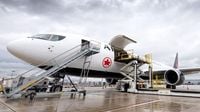In a dramatic turn of events affecting tens of thousands of travelers and workers, the Canadian government has stepped in to end a nationwide strike by Air Canada’s flight attendants, imposing binding arbitration just hours after the walkout began. The move, announced on August 16, 2025, halted a labor action that had threatened to paralyze the country’s largest airline and disrupt vital economic and supply chain activities across Canada and beyond.
The strike, which commenced at 1 a.m. on Saturday, followed eight months of fruitless negotiations between Air Canada and the Canadian Union of Public Employees (CUPE), the union representing the airline’s 10,000 flight attendants. The dispute centered on a contentious issue: compensation for time spent on the ground between flights and while assisting passengers during boarding. Currently, flight crews are only paid when their aircraft is moving, a policy CUPE has criticized as unfair and outdated.
Minister of Jobs and Families Patty Hajdu, who also oversees labor policy, convened with both parties late Friday night in a last-ditch attempt to broker a deal. After assessing the situation, Hajdu concluded that the two sides were simply too far apart. “They are so far apart on a number of issues that they are going to need some help,” she told The Wall Street Journal. She added, “This is not a decision that I’ve taken lightly, but the potential for immediate negative impact on Canadians and our economy is simply too great.”
The government’s decision to impose binding arbitration was not made in a vacuum. As reported by AFP and AP, Air Canada transports about 130,000 passengers daily, operates nearly 200 flights to the United States each day, and serves almost 60 countries worldwide. The strike’s ripple effects were immediate and severe: flights were canceled, supply chains threatened, and businesses braced for disruption. Air Canada Cargo scrambled to keep its freighter fleet running on a modified schedule to ensure the delivery of critical goods such as pharmaceuticals, perishable foods, and machinery.
Business groups, including the Canadian Chamber of Commerce and the Canadian Federation of Independent Businesses, had already raised alarms. According to FreightWaves, these organizations warned that the work stoppage might “hinder the flow of critical goods such as pharmaceuticals, perishable foods, and machinery and hurt companies already impacted by escalating trade tensions with the United States.” The timing could hardly have been worse, as Canada’s economy faces new tariff headwinds and ongoing uncertainty in global trade.
The government’s intervention, requested by Air Canada and several business coalitions, was framed as a necessary measure to protect the broader public interest. “It has now become clear that this dispute won’t be resolved at the table. Canadians are increasingly finding themselves in very difficult situations and the strike is rapidly impacting the Canadian economy,” Hajdu said in a statement. “The enormous impact of a nationwide labour disruption of this scale is already being felt by Canadians and visitors to our country. This impact will grow significantly with a prolonged dispute.”
Hajdu directed the Canadian Industrial Relations Board to oversee binding arbitration, a process in which the board will hear from both sides and set the terms of a new contract that both Air Canada and CUPE must accept. The government left a narrow window for the parties to reach a last-minute deal on their own, but binding arbitration remains the default path forward.
The union, however, was quick to denounce the government’s move. In a sharply worded statement, CUPE accused the Liberal government—now under Mark Carney—of undermining workers’ rights. “The Liberal government under Mark Carney has done incalculable damage to the charter and workers’ rights by siding with Air Canada to crush the rights of flight attendants at Air Canada,” the union said. CUPE National Secretary-Treasurer Candace Rennick went further, declaring, “The government’s decision to intervene on behalf of an already wildly profitable employer, while a predominantly female workforce fights tooth and nail for a path out of poverty, is not just unjust, it’s a disgraceful misuse of power that reeks of systemic bias and corporate favoritism.”
CUPE also claimed that Air Canada’s offer would raise wages by only 17% over four years—a figure the union says fails to keep pace with inflation and does not address lost ground under the current contract. Air Canada, for its part, asserted that its proposal would boost total compensation by 38% over the same period, though this figure includes benefits and pensions, not just base wages. The union described its own proposals as “reasonable” and accused the airline of “sandbagging the talks.”
For Air Canada passengers and shippers, the government’s intervention brought a measure of relief, but uncertainty remains. Air Canada announced that flights would remain canceled until Sunday afternoon, pending more details about the arbitration process. The airline said it was too soon to discuss when normal operations would resume, given that the arbitration order had just been unveiled. The company began grounding its fleet as early as Thursday in anticipation of the strike deadline, set by CUPE for Saturday morning.
The government’s decisive action in the Air Canada dispute is part of a broader trend. In December 2024, Ottawa ended a month-long strike by Canada Post workers and ordered the Industrial Relations Board to recommend solutions for the postal operator’s financial woes. More recently, Hajdu instructed the board to poll members of the Canadian Union of Postal Workers on Canada Post’s final contract offer, even over the objections of union leaders. That proposal was overwhelmingly rejected by mail carriers on August 1, 2025.
For many Canadians, the Air Canada strike and its abrupt resolution highlight the delicate balance between protecting essential services and respecting the rights of workers to bargain collectively. The government’s willingness to step in—especially in critical sectors—has sparked debate about the appropriate limits of intervention and the future of labor relations in Canada. As the country watches the arbitration process unfold, all eyes are on whether a fair and lasting settlement can be reached for the thousands of flight attendants who keep Canada’s skies moving, and for the passengers and businesses who depend on them every day.
With flight schedules still in flux and the arbitration process just beginning, travelers, workers, and business leaders alike are left waiting for the dust to settle on one of Canada’s most high-profile labor disputes in recent memory.




